Grilled Spring Vegetables

Fresh and Flavorful Grilled Spring Vegetables: A Seasonal Favorite!
Grilled Spring Vegetables are the perfect way to showcase the fresh, vibrant produce of the season. With tender asparagus, sweet bell peppers, juicy cherry tomatoes, and perfectly charred zucchini, this dish brings together the best of spring in one flavorful recipe. Whether you’re grilling outdoors or using a grill pan in your kitchen, these vegetables are a quick and healthy addition to any meal.
Not only are Grilled Spring Vegetables easy to prepare, but they’re also incredibly versatile. Serve them as a colorful side dish, toss them into a hearty salad, or pair them with your favorite protein for a complete meal. Packed with nutrients and naturally gluten-free, this recipe is a delicious way to eat clean while embracing the smoky, caramelized flavors of the grill. Ready to bring the taste of spring to your table? Let’s get started!
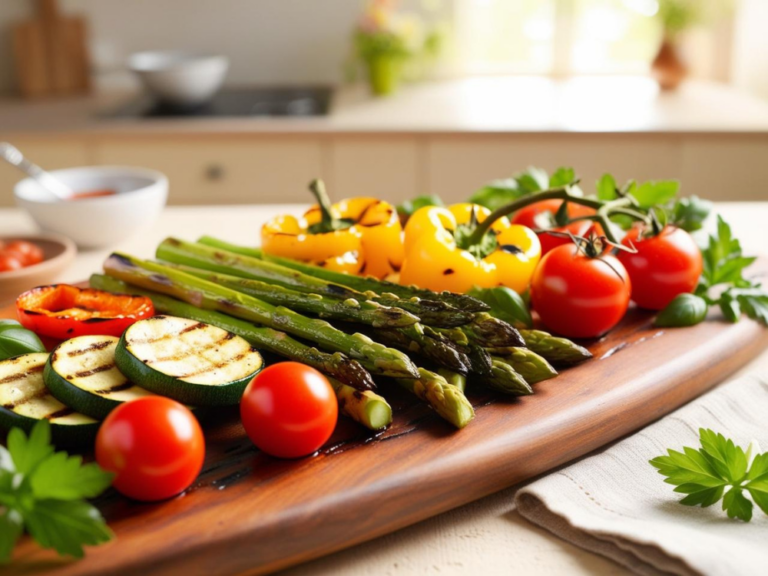
Nutritional Benefits of Grilled Spring Vegetables
Grilled Spring Vegetables are more than just a delicious side dish—they’re packed with incredible nutritional benefits that make them a powerhouse addition to your meals. This colorful medley of asparagus, zucchini, bell peppers, and cherry tomatoes brings a variety of vitamins, minerals, and antioxidants to the table, helping you nourish your body while enjoying a flavorful dish.
Take asparagus, for example. It’s a rich source of folate, which supports healthy cell function and is especially important for expecting mothers. It also contains antioxidants like glutathione that help protect your cells from damage. Zucchini is another standout, boasting a high water content that keeps you hydrated while providing essential nutrients like vitamin C and potassium, which are great for your skin and heart health.
Bell peppers, with their vibrant colors, aren’t just pretty—they’re also nutritional all-stars. Red bell peppers, in particular, are loaded with vitamin C (even more than oranges!) and beta-carotene, which supports your immune system and eye health. Finally, cherry tomatoes are small but mighty, packed with lycopene, a powerful antioxidant known for reducing inflammation and promoting heart health.
Grilling these vegetables not only enhances their natural sweetness but also preserves many of their key nutrients. The quick cooking process helps retain vitamins while giving the veggies that irresistible smoky, caramelized flavor. Plus, since this recipe uses minimal oil and relies on fresh herbs and natural seasonings, it fits perfectly into a clean eating or low-calorie lifestyle.
Incorporating Grilled Spring Vegetables into your meals isn’t just about enjoying a tasty dish—it’s about fueling your body with the nutrients it needs to thrive. Whether you’re aiming to eat healthier, boost your immune system, or simply enjoy the season’s freshest produce, this recipe has you covered. So fire up the grill and let these veggies work their magic, one nutrient-packed bite at a time!
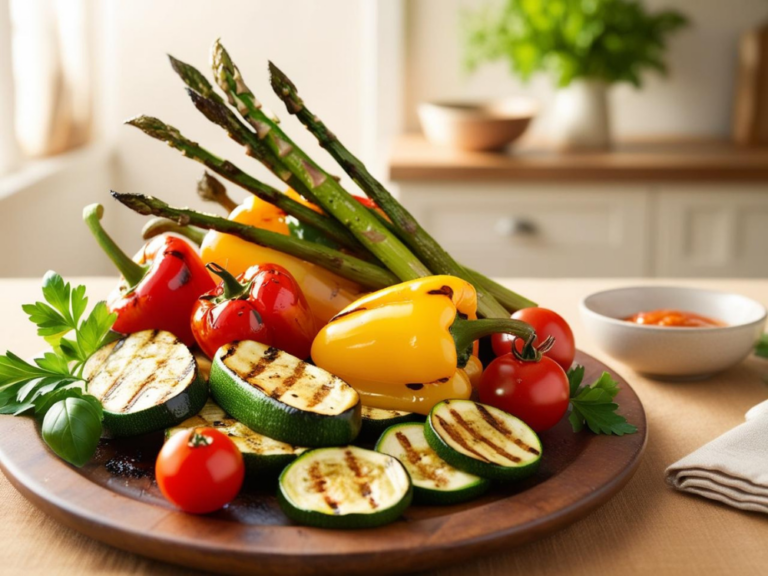
Perfect Pairing Suggestions for Grilled Spring Vegetables
Grilled Spring Vegetables are a versatile dish that can complement just about any meal. Whether you’re serving them as a side, tossing them into a larger dish, or making them the star of your plate, the possibilities are endless. With their smoky, slightly sweet flavor and vibrant colors, they pair beautifully with a variety of proteins, grains, sauces, and beverages to create a well-rounded and satisfying meal. Here are some delicious pairing ideas to inspire you.
1. Proteins That Shine Alongside Grilled Spring Vegetables
Grilled Spring Vegetables make an excellent side dish for almost any protein. Pair them with:
- Grilled Chicken: Juicy, herb-marinated chicken pairs perfectly with the charred flavors of the vegetables. Add a squeeze of lemon for a bright, fresh finish.
- Salmon or Other Fish: The smoky sweetness of the vegetables complements the rich flavor of grilled salmon, trout, or even shrimp. A drizzle of lemon-butter sauce ties it all together.
- Steak: For a hearty meal, pair your Grilled Spring Vegetables with a perfectly grilled steak. The vegetables provide a fresh contrast to the richness of the meat.
- Plant-Based Proteins: Grilled tofu or tempeh works wonderfully, especially if marinated in flavors like soy sauce, ginger, and garlic. You can even serve the vegetables over a bed of quinoa or lentils for a plant-based protein boost.
2. Grains and Starches for a Balanced Plate
Round out your meal by serving Grilled Spring Vegetables with hearty grains or starches:
- Rice or Quinoa: Serve the vegetables over a bed of fluffy rice or quinoa for a wholesome and filling side. You can even toss them together for a grilled vegetable pilaf.
- Couscous or Orzo: Light, fluffy couscous or orzo pasta makes an excellent base for the veggies, especially when mixed with olive oil and fresh herbs.
- Crusty Bread: Pair the vegetables with a warm slice of crusty artisan bread. Add a dollop of hummus or a drizzle of olive oil for a simple yet satisfying side.
- Potatoes: Roasted or mashed potatoes, or even a baked sweet potato, pair wonderfully with the smoky flavors of Grilled Spring Vegetables.
3. Sauces and Dips to Elevate the Flavor
Grilled Spring Vegetables can stand alone, but a flavorful sauce or dip can take them to the next level:
- Tzatziki Sauce: The cool, creamy tanginess of tzatziki is a refreshing contrast to the smoky vegetables.
- Chimichurri: A vibrant herb-based chimichurri sauce adds a punch of flavor that complements grilled vegetables beautifully.
- Hummus: Serve the vegetables with a side of creamy hummus for dipping, or drizzle it over the top for a Mediterranean-inspired dish.
- Pesto: Whether it’s classic basil pesto or a sun-dried tomato variation, the rich, savory flavors pair perfectly with the grilled veggies.
4. Creative Serving Ideas
Looking to switch things up? Use Grilled Spring Vegetables in these creative ways:
- Tacos or Wraps: Stuff the vegetables into soft tortillas or wraps with a dollop of guacamole or salsa for a quick and healthy meal.
- Salads: Toss the grilled vegetables into a fresh salad with arugula, spinach, or mixed greens, then top with feta cheese and a balsamic vinaigrette.
- Pasta Dishes: Add the vegetables to your favorite pasta for a smoky twist. They’re especially delicious in a light olive oil or garlic-based sauce.
- Pizza Topping: Use the vegetables as a topping for a grilled pizza. Add a sprinkle of mozzarella or goat cheese for extra indulgence.
5. Beverage Pairings to Complete the Meal
No meal is complete without the perfect drink! Here are some options to complement Grilled Spring Vegetables:
- Wine: A crisp white wine like Sauvignon Blanc or a light red like Pinot Noir pairs wonderfully with the smoky and fresh flavors of the vegetables.
- Beer: A refreshing pale ale or a light wheat beer enhances the smoky and slightly sweet notes of the dish.
- Mocktails: Try a sparkling cucumber mint water or a lemon and basil spritzer for a non-alcoholic option that’s just as refreshing.
6. Dessert to Finish It Off
For a perfectly balanced meal, finish with a light dessert that complements the freshness of the vegetables:
- Fresh Fruit Salad: A bowl of fresh seasonal fruits like berries, melon, and kiwi is a refreshing way to wrap up your meal.
- Sorbet: A scoop of lemon or mango sorbet is light, tangy, and refreshing after a vegetable-heavy dish.
By mixing and matching these pairing suggestions, you can create a meal that’s both satisfying and unforgettable. Grilled Spring Vegetables are incredibly versatile, so don’t be afraid to get creative and make the dish your own. Whether you’re serving them alongside grilled salmon, tossing them into a quinoa salad, or enjoying them in a wrap, these vegetables are guaranteed to elevate your meal.
Try some of our other recipes!
Creative Serving Ideas for Grilled Spring Vegetables
Grilled Spring Vegetables are not just a side dish—they’re a versatile addition to countless meals that can be dressed up or down depending on the occasion. Their smoky, caramelized flavor and vibrant colors make them a show-stopping element in everything from casual weeknight dinners to elegant gatherings. Whether you’re serving them as part of a larger spread or incorporating them into main dishes, here are some creative and delicious ways to enjoy Grilled Spring Vegetables.
1. The Perfect Side Dish
One of the simplest ways to serve Grilled Spring Vegetables is as a classic side dish. Arrange the vegetables on a rustic platter and drizzle them with olive oil and a sprinkle of sea salt for a beautiful, no-fuss presentation. They pair wonderfully with grilled proteins like chicken, fish, or steak, adding a fresh, nutritious contrast to the richness of the main course.
2. Toss Them Into a Salad
Elevate your salad game by adding Grilled Spring Vegetables to the mix. Toss the grilled zucchini, bell peppers, and asparagus with mixed greens, cherry tomatoes, and crumbled feta or goat cheese. Top it off with a balsamic vinaigrette or a tangy lemon dressing. For a heartier salad, add quinoa, farro, or orzo for extra texture and nutrition.
3. Make It a Main Course
Grilled Spring Vegetables can easily take center stage as a main course. Serve them over a bed of fluffy couscous, quinoa, or rice, and drizzle with a creamy tahini or herb sauce. For a plant-based protein boost, toss in chickpeas or grilled tofu. Add some toasted nuts or seeds for crunch, and you’ve got a wholesome, filling meal.
4. Build Flavorful Wraps and Sandwiches
Turn your Grilled Spring Vegetables into a handheld feast by stuffing them into wraps, pita bread, or sandwiches. Add hummus, tzatziki, or avocado spread for extra flavor, and don’t forget a handful of fresh greens. Wraps and sandwiches are perfect for meal prep or on-the-go lunches that are both healthy and satisfying.
5. Top a Pizza or Flatbread
Grilled Spring Vegetables make a stunning and delicious topping for pizza or flatbread. Start with your favorite crust, spread a layer of pesto or marinara sauce, and load it up with the charred vegetables. Sprinkle mozzarella, Parmesan, or even crumbled goat cheese on top, then bake until bubbly. This is an easy way to bring restaurant-quality pizza to your home kitchen.
6. Add to a Pasta Dish
Transform your favorite pasta dish with the addition of Grilled Spring Vegetables. Toss them into spaghetti, penne, or linguine with olive oil, garlic, and fresh basil for a light, summery meal. If you’re feeling indulgent, add a dollop of ricotta or a sprinkle of Parmesan cheese. These vegetables also work beautifully in baked pasta dishes like lasagna or ziti.
7. Build a Grain Bowl
Grain bowls are the perfect way to turn Grilled Spring Vegetables into a nutritious and customizable meal. Start with a base of quinoa, rice, or farro, then layer on the grilled veggies, a protein of your choice (like grilled chicken, salmon, or chickpeas), and finish with a drizzle of tahini, yogurt dressing, or vinaigrette. Add extras like avocado slices, nuts, or seeds for added flavor and texture.
8. Use Them as a Topping for Soup
Add a burst of flavor and color to soups by garnishing them with Grilled Spring Vegetables. They pair particularly well with creamy soups like tomato bisque, roasted red pepper, or butternut squash soup. The smoky flavor of the grilled veggies adds depth and texture, making the dish even more satisfying.
9. Serve Them as an Appetizer
For a party or casual gathering, serve Grilled Spring Vegetables as a crowd-pleasing appetizer. Skewer the vegetables for easy serving, and pair them with a dipping sauce like garlic aioli, tzatziki, or romesco. This is a light yet flavorful option that’s perfect for entertaining.
10. Mix Into Breakfast Dishes
Don’t forget that Grilled Spring Vegetables can be a part of your breakfast, too! Chop them up and fold them into an omelet or frittata, or use them as a topping for avocado toast. You can also toss them into a breakfast burrito with scrambled eggs and cheese for a flavorful start to your day.
11. Create Stunning Platter Presentations
If you’re hosting a dinner party, consider arranging Grilled Spring Vegetables on a large serving platter alongside fresh herbs, lemon wedges, and a drizzle of olive oil. This rustic, colorful display is as visually appealing as it is delicious and will wow your guests.
12. Incorporate Them Into Tacos
For a fun twist, use Grilled Spring Vegetables as a taco filling. Pair them with black beans, avocado, and a dollop of chipotle crema for a smoky, slightly spicy taco night. Add a squeeze of lime and some chopped cilantro for a burst of freshness.
13. Repurpose Leftovers
If you have leftover Grilled Spring Vegetables, don’t let them go to waste! Use them as a topping for baked potatoes, toss them into stir-fries, or blend them into a soup or sauce for added flavor. Leftover grilled veggies can also be chopped up and used as a filling for savory crepes or galettes.
With so many serving possibilities, Grilled Spring Vegetables are a versatile dish that you’ll never tire of. Whether they’re enhancing a simple salad, elevating your pizza night, or stealing the spotlight as a main course, these vegetables are sure to add flavor, color, and nutrition to your meals. Get creative, mix and match ideas, and let these serving suggestions inspire you to enjoy Grilled Spring Vegetables in exciting new ways!
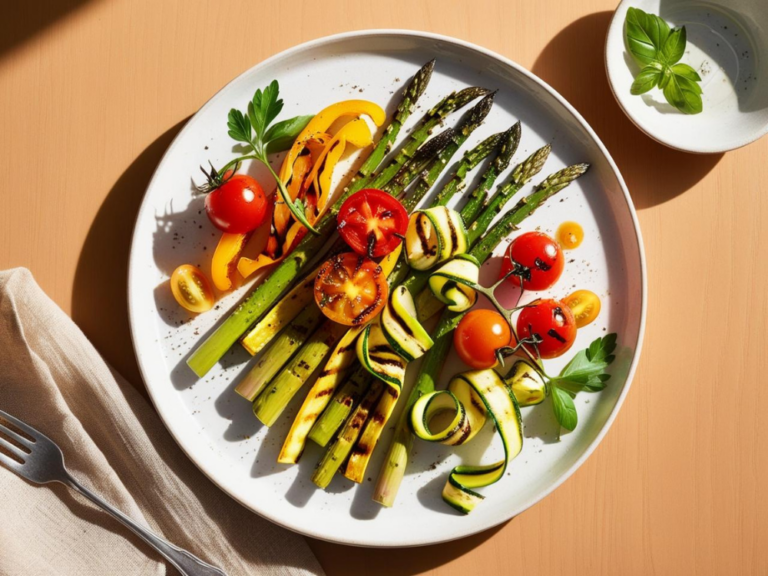
Why Grilled Spring Vegetables Are Perfect for Clean Eating
If you’re looking for a dish that aligns with your clean eating goals, Grilled Spring Vegetables should be at the top of your list. This vibrant, nutrient-packed recipe is not only delicious but also embodies everything that clean eating is all about: fresh, whole ingredients, minimal processing, and maximum flavor. Whether you’re a seasoned clean eater or just starting your journey, here’s why Grilled Spring Vegetables are a perfect fit for your lifestyle.
1. They’re Made with Whole, Fresh Ingredients
Clean eating begins with using fresh, whole foods, and Grilled Spring Vegetables deliver exactly that. The recipe relies on simple, seasonal vegetables like asparagus, zucchini, bell peppers, and cherry tomatoes. These are nutrient-dense ingredients straight from the earth, free from preservatives, additives, or artificial ingredients. By choosing fresh produce, you’re fueling your body with natural vitamins, minerals, and antioxidants that are essential for your health.
2. Minimal Ingredients, Maximum Flavor
One of the best things about Grilled Spring Vegetables is that you don’t need a long list of ingredients to create a delicious dish. A drizzle of olive oil, a sprinkle of sea salt and black pepper, and a handful of fresh herbs like parsley or basil are all you need to bring out the vegetables’ natural flavors. This simplicity not only makes the dish easy to prepare but also keeps it aligned with clean eating principles by avoiding unnecessary additives.
3. Naturally Low in Calories and High in Nutrients
If you’re focusing on eating clean, you’re probably also looking for meals that are both nourishing and satisfying. Grilled Spring Vegetables are naturally low in calories while being rich in fiber, vitamins, and minerals. For example:
- Asparagus is a great source of folate and vitamins A, C, and K.
- Zucchini is packed with hydration and vitamin C.
- Bell peppers are loaded with vitamin C and antioxidants.
- Cherry tomatoes contain lycopene, a powerful antioxidant known for its anti-inflammatory properties.
This nutrient-packed combination helps you feel full and energized without weighing you down, making it perfect for clean eating.
4. No Heavy Sauces or Processed Additives
Unlike many side dishes that rely on creamy dressings, sugary glazes, or processed seasonings, Grilled Spring Vegetables shine in their natural simplicity. The recipe emphasizes clean, healthy fats from olive oil, fresh herbs, and natural seasonings. This keeps the dish wholesome and free from hidden sugars, unhealthy trans fats, or artificial flavors that can derail your clean eating goals.
5. Easy to Customize for Dietary Needs
Grilled Spring Vegetables are naturally gluten-free, dairy-free, and vegetarian, making them a versatile choice for a variety of clean eating plans. Whether you’re following a vegan, paleo, or keto diet, these vegetables can be tailored to fit seamlessly. For example, keto eaters can add a high-fat dipping sauce like garlic aioli, while those following a Mediterranean diet might drizzle the veggies with lemon juice and sprinkle them with feta cheese.
6. Supports Sustainable and Mindful Eating
Clean eating isn’t just about the ingredients you choose—it’s also about eating mindfully and sustainably. Grilled Spring Vegetables encourage you to savor the flavors of seasonal produce and support local farmers by buying fresh, in-season vegetables. Plus, grilling is an eco-friendly cooking method that uses minimal energy and produces fewer dishes to clean.
7. Quick and Easy for a Busy Lifestyle
Clean eating can sometimes feel intimidating, especially if you’re short on time. However, Grilled Spring Vegetables are incredibly quick and easy to prepare. With just a few minutes of chopping and seasoning, your vegetables are ready to hit the grill. In under 20 minutes, you’ll have a delicious and nutrient-rich dish that fits your clean eating goals without the hassle of complicated recipes.
8. Encourages Healthy Eating Habits
One of the keys to clean eating is building a habit of incorporating fresh, wholesome foods into your meals. Grilled Spring Vegetables are a delicious way to make vegetables a staple on your plate. Their bold flavors and satisfying textures can even win over picky eaters, helping to create a long-term habit of choosing nutritious, whole foods over processed options.
9. A Foundation for Endless Clean Eating Recipes
Grilled Spring Vegetables are more than a standalone dish—they’re a foundation for countless clean eating meals. Toss them into a grain bowl with quinoa and a tahini dressing, use them as a topping for a salad, or mix them with chickpeas and fresh herbs for a light lunch. Their versatility makes it easy to incorporate them into your meal plan without getting bored.
10. Packed with Flavor Without Compromise
Clean eating doesn’t mean sacrificing flavor, and Grilled Spring Vegetables prove that. The natural caramelization from grilling enhances the vegetables’ sweetness while adding a smoky depth that’s irresistible. With the addition of fresh herbs, citrus, or a touch of garlic, you get a dish that’s bursting with flavor without relying on unhealthy additives.
Grilled Spring Vegetables are a perfect example of how clean eating can be simple, flavorful, and nourishing. By focusing on fresh, whole ingredients and easy preparation, this dish supports your health goals without feeling restrictive. Whether you’re serving them as a side dish, incorporating them into a main meal, or enjoying them on their own, Grilled Spring Vegetables are a delicious and wholesome way to embrace clean eating. So fire up the grill, enjoy the natural goodness of seasonal vegetables, and feel great about the food you’re putting on your plate!
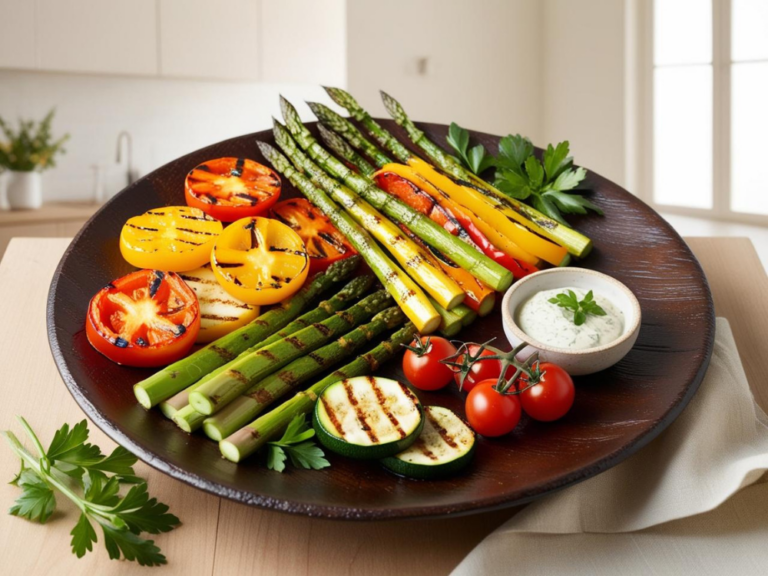
Health Benefits of Grilling
Grilling isn’t just a delicious way to cook—it’s also one of the healthiest cooking methods available. Whether you’re making Grilled Spring Vegetables, your favorite protein, or a combination of both, grilling offers a variety of health benefits that can elevate your meals while keeping them nutritious. From preserving nutrients to reducing the need for added fats, grilling is a cooking technique that aligns perfectly with a healthy lifestyle. Let’s dive into why grilling is so good for you.
1. Preserves Nutrients in Food
One of the best things about grilling is how it locks in the nutrients of the food you’re cooking. When you grill vegetables like asparagus, zucchini, or bell peppers, the quick, high heat helps retain water-soluble vitamins, such as vitamin C and many B vitamins, that are often lost during boiling or frying. This means your Grilled Spring Vegetables will be packed with the essential nutrients your body needs to thrive.
2. Reduces the Need for Added Fats
Unlike frying or sautéing, grilling requires little to no added fats. A light drizzle of olive oil is often all you need to prevent sticking and enhance flavor, which keeps your meals lower in calories while still being satisfying. For example, Grilled Spring Vegetables develop a smoky, caramelized flavor naturally, without the need for heavy sauces or butter. This makes grilling an excellent choice for anyone looking to eat clean or reduce their calorie intake.
3. Adds Smoky Flavor Without Unhealthy Additives
Grilling enhances the natural flavors of food, thanks to the caramelization process and smoky aroma it creates. This means you can skip processed marinades, artificial flavorings, or heavy condiments and still enjoy a dish that tastes incredible. With Grilled Spring Vegetables, you can let the natural sweetness of the vegetables shine through, amplified by the subtle smokiness from the grill.
4. Helps Reduce Fat Content in Proteins
When you grill meats like chicken, steak, or fish, the excess fat drips off through the grill grates. This not only reduces the fat content of the final dish but also helps you avoid consuming unnecessary grease. Grilling is especially beneficial for lean cuts of meat or plant-based proteins like tofu, as it enhances their flavor while keeping the meal healthy and light.
5. Supports Healthy Digestion
Grilling can also contribute to better digestion by making certain foods easier to break down. Vegetables, for instance, soften during grilling while retaining their fiber content. This combination of tenderness and fiber is excellent for supporting healthy digestion and keeping your gut happy. A plate of Grilled Spring Vegetables, for example, is a perfect balance of tender texture and high-fiber content that’s gentle on the stomach.
6. Lowers Risk of Overcooking
Overcooking food not only affects its taste but can also deplete its nutrient content. Grilling, with its quick cooking times, helps prevent overcooking and preserves the natural goodness of your ingredients. Vegetables like zucchini and cherry tomatoes cook quickly on the grill, maintaining their vitamins, minerals, and natural flavors.
7. Encourages Healthy Meal Choices
Grilling is often associated with fresh, wholesome ingredients like vegetables, lean meats, and seafood. Preparing meals on the grill naturally steers you toward healthier choices, as the method lends itself to simple, nutrient-rich dishes. For example, a plate of Grilled Spring Vegetables with a side of grilled fish or chicken is a complete, balanced meal that’s packed with nutrients.
8. Boosts Antioxidant Levels
Did you know that grilling can actually increase the antioxidant content in some vegetables? Research has shown that grilling enhances the levels of certain antioxidants, such as carotenoids in bell peppers and lycopene in tomatoes. These antioxidants help fight inflammation and protect your cells from damage, making grilled vegetables not only delicious but also a powerful addition to your diet.
9. Promotes a Balanced Lifestyle
Grilling isn’t just a cooking method—it’s an experience. It encourages you to step outside, enjoy the fresh air, and connect with family and friends. This social aspect of grilling contributes to overall well-being, creating a balanced lifestyle that values good food and meaningful moments. Imagine sharing a platter of Grilled Spring Vegetables with loved ones at a backyard barbecue—it’s a healthy and memorable way to enjoy your meals.
10. Easy to Incorporate Into Any Diet
Grilling is incredibly versatile, making it suitable for nearly every dietary preference or lifestyle. Whether you’re following a vegetarian, keto, paleo, or clean eating plan, grilling allows you to prepare foods in a way that aligns with your health goals. Grilled Spring Vegetables, for example, are naturally gluten-free, low in calories, and packed with nutrients, making them a perfect fit for a wide range of diets.
11. Encourages Mindful Eating
Grilling brings out the natural beauty of food—vibrant colors, smoky aromas, and caramelized edges—that make meals more visually and sensorially appealing. This encourages mindful eating, where you savor each bite and appreciate the flavors, textures, and effort that went into your dish. Grilled Spring Vegetables, with their bright colors and rich flavors, are a prime example of how grilling can turn simple ingredients into a feast for the senses.
Grilling is more than just a way to cook—it’s a way to unlock the full potential of your ingredients while keeping your meals healthy and flavorful. Whether you’re preparing Grilled Spring Vegetables or your favorite protein, this cooking method preserves nutrients, enhances flavor, and supports a balanced lifestyle. The next time you fire up the grill, know that you’re not just making a delicious meal—you’re making a healthier choice for your body and mind. So grab your fresh vegetables, season them lightly, and enjoy the many health benefits of grilling!
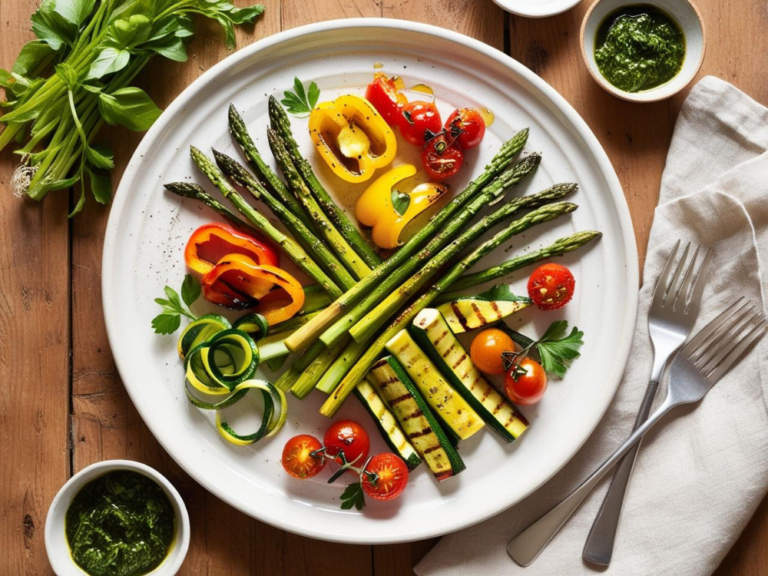
Common Grilling Mistakes to Avoid
Grilling is one of the most enjoyable and rewarding cooking methods, especially when it comes to recipes like Grilled Spring Vegetables. The smoky flavor, charred edges, and vibrant colors make it a favorite for outdoor and indoor cooks alike. However, grilling isn’t without its pitfalls, and a few simple mistakes can turn your perfectly planned dish into a less-than-stellar experience. To help you grill like a pro, here are some common grilling mistakes to avoid and tips to ensure your Grilled Spring Vegetables come out perfect every time.
1. Not Preheating the Grill
Skipping the preheat step is one of the most common grilling mistakes. A cold grill can cause uneven cooking and prevent your vegetables from achieving those beautiful grill marks. Always preheat your grill for 10–15 minutes before placing any food on it. For Grilled Spring Vegetables, a properly heated grill ensures a quick sear that locks in flavor and preserves nutrients.
2. Overcrowding the Grill Grates
It can be tempting to pile all your vegetables on the grill at once, especially when cooking for a crowd, but overcrowding prevents proper airflow and even cooking. Overcrowded grills can lead to steaming rather than grilling, resulting in soggy vegetables instead of that desirable char. Give your veggies enough space to cook evenly and turn easily. If you’re short on space, cook in batches.
3. Not Using the Right Oil
Using the wrong oil can lead to sticking and smoking problems. Oils with low smoke points, like butter or unrefined olive oil, can burn quickly and impart an unpleasant flavor. Instead, use a high-smoke-point oil like avocado oil, grapeseed oil, or even refined olive oil to coat your Grilled Spring Vegetables before placing them on the grill. This helps prevent sticking and ensures a smooth grilling process.
4. Ignoring Proper Vegetable Prep
Throwing vegetables on the grill without prepping them properly is a recipe for disaster. Vegetables should be washed, dried, and cut into uniform sizes to ensure even cooking. For Grilled Spring Vegetables, aim to slice zucchini and bell peppers into thick strips and trim asparagus to similar lengths. Uniform sizes prevent some pieces from burning while others remain undercooked.
5. Forgetting to Oil the Grill Grates
Even if you’ve oiled your vegetables, failing to oil the grill grates can lead to sticking. Before placing your vegetables on the grill, use a grill brush or paper towel dipped in oil to lightly coat the grates. This step is especially important for delicate items like zucchini and asparagus, which can tear or fall apart if they stick.
6. Using Too Much Marinade or Sauce
While marinades and sauces can add flavor, using too much can cause flare-ups and uneven cooking. Excess oil or sugar-based marinades can drip onto the flames, leading to charring and bitter-tasting vegetables. To avoid this, lightly coat your Grilled Spring Vegetables with marinade and shake off any excess before placing them on the grill. Save the sauces for drizzling after cooking.
7. Turning Vegetables Too Frequently
Constantly flipping and moving vegetables around on the grill can prevent them from developing proper grill marks and caramelization. Vegetables need time to sit undisturbed on the grill to achieve that smoky, charred flavor. For Grilled Spring Vegetables, let them cook for a few minutes on each side before flipping, and only turn them once or twice during the cooking process.
8. Cooking on Too High Heat
High heat is great for searing, but too much heat can scorch the outside of your vegetables while leaving the inside undercooked. To avoid this, use medium heat for most vegetables to ensure even cooking. Delicate vegetables like cherry tomatoes can burst if the heat is too high, so keep an eye on your grill’s temperature and adjust as needed.
9. Skipping the Resting Step
Just like with grilled meats, vegetables benefit from a short resting period after they’re removed from the grill. Letting your Grilled Spring Vegetables rest for 2–3 minutes allows the juices to redistribute, ensuring they’re tender and flavorful. Plus, this prevents the vegetables from being too hot to enjoy right away.
10. Neglecting to Clean the Grill Grates
Dirty grill grates can ruin the flavor of your vegetables and cause sticking. Before and after grilling, use a grill brush to clean the grates and remove any charred residue. For an extra-clean surface, heat the grill and brush the grates again before oiling. Clean grates ensure your Grilled Spring Vegetables cook evenly and taste fresh.
11. Not Monitoring the Cooking Time
Grilling vegetables is a fast process, and it’s easy to lose track of time. Overcooked vegetables can become mushy and lose their vibrant colors. Keep a close eye on your Grilled Spring Vegetables, as different vegetables have different cooking times. For example, asparagus may cook in 5–7 minutes, while thicker zucchini slices may take 8–10 minutes. Having a timer handy can be a lifesaver.
12. Forgetting to Experiment and Adjust
Grilling is as much an art as it is a science, and every grill is a little different. Don’t be afraid to experiment with your setup, adjust the heat, or try different seasonings. The beauty of Grilled Spring Vegetables is their versatility, so have fun and tweak the process to suit your taste and grilling style.
By avoiding these common mistakes, you’ll not only ensure your Grilled Spring Vegetables turn out perfect every time but also make the grilling process more enjoyable and stress-free. A little preparation and attention to detail can go a long way in creating a dish that’s bursting with flavor, texture, and visual appeal. So fire up the grill, keep these tips in mind, and enjoy the satisfaction of perfectly grilled vegetables every time!
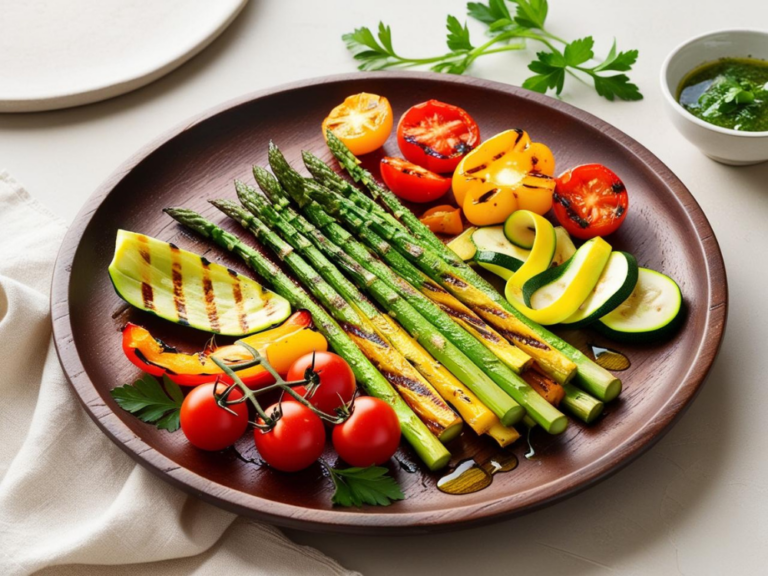
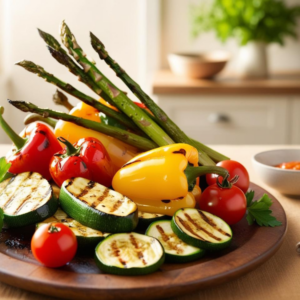
Grilled Spring Vegetables
Equipment
- Grill: An outdoor grill (charcoal or gas) or an indoor grill pan for cooking the vegetables.
- Tongs: For flipping and handling the vegetables on the grill.
- Cutting Board: To chop and prepare the vegetables.
- Chef’s Knife: For slicing the vegetables into uniform pieces.
- Mixing Bowl: To toss the vegetables with olive oil, herbs, and seasonings.
- Basting Brush: For lightly coating the grill grates with oil (optional).
- Grill Basket or Skewers: To prevent smaller vegetables, like cherry tomatoes, from falling through the grates (optional but helpful).
- Measuring Spoons: For measuring olive oil and seasonings accurately.
Ingredients
- 1 Zucchini, sliced into ½-inch rounds
- 1 Yellow squash, sliced into ½-inch rounds
- 1 Red bell pepper, cut into 1-inch pieces
- 1 Bunch of asparagus, ends trimmed
- 1 Cup Cherry tomatoes
- 2 Tbsp Olive oil
- Salt and pepper, to taste
- Optional: fresh herbs (like basil or thyme), lemon wedges for serving
Instructions
- Preheat your grill: Get your grill going at a medium-high heat. You want it hot enough to char the veggies slightly, but not so hot that they turn into charcoal.
- Prep your veggies: While the grill heats up, toss your cut veggies in a large bowl with olive oil, salt, and pepper. If you're using fresh herbs, chop them up and throw them into the mix as well.
- Grill 'em up: Lay your vegetables on the grill in a single layer, giving them a little space to breathe. Grill for about 3-4 minutes on each side, or until they're tender and have those gorgeous grill marks. For the cherry tomatoes, use a grill basket or skewer them to keep them from falling through the grates
- Serve and enjoy: Once grilled to perfection, transfer the vegetables to a serving platter. Squeeze some lemon over the top for an extra zing and sprinkle with more fresh herbs if you like.
Notes
Grilled Spring Vegetables are a fantastic option for meal prep or planning ahead for gatherings. Here’s how you can prepare them in advance:
- Prepping Ahead: Wash, dry, and cut all your vegetables up to 2 days in advance. Store them in an airtight container in the refrigerator until ready to grill.
- Marinate Early: Toss your vegetables with olive oil, herbs, and seasonings a few hours before grilling. This allows the flavors to infuse while you focus on other prep.
- Grill in Advance: You can grill the vegetables up to a day ahead of time. Once cooked, let them cool completely, then store in an airtight container in the fridge. Simply reheat when ready to serve.
- Refrigerator: Store leftover Grilled Spring Vegetables in an airtight container for up to 3–4 days. They’re just as tasty cold, but you can reheat them for a warm side dish.
- Freezer: While freezing is not ideal for all vegetables due to texture changes, sturdier options like bell peppers and zucchini can be frozen for up to 2 months. Spread them on a baking sheet to freeze individually before transferring to a freezer-safe container or bag.
- Reheating: Reheat the vegetables in a skillet over medium heat or on the grill for a few minutes. Alternatively, use the microwave for a quick reheat, though it may slightly soften the texture.
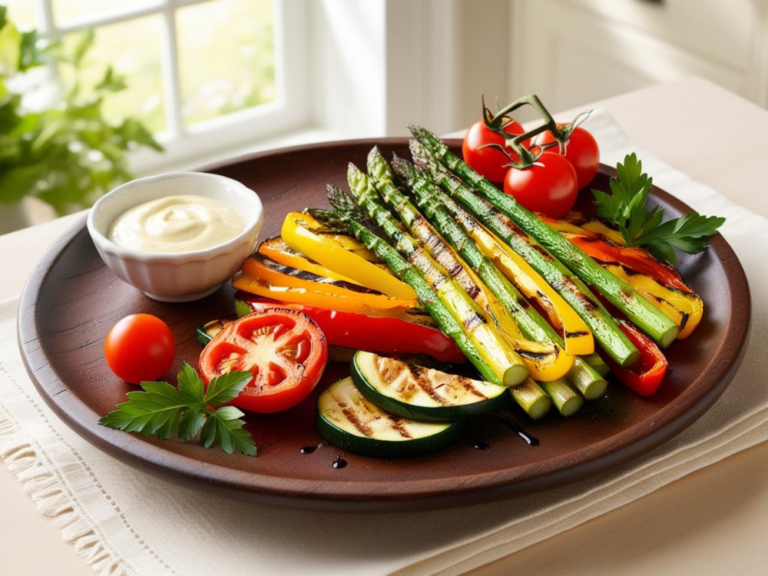
Bringing It All Together
Grilled Spring Vegetables are more than just a dish—they’re a celebration of fresh, seasonal flavors that bring vibrancy and nourishment to your table. Whether you’re enjoying them as a side dish, a main course, or adding them to salads, wraps, or bowls, these vegetables are versatile, delicious, and packed with nutrients.
Grilling brings out their natural sweetness and enhances their smoky, charred edges, making every bite a satisfying experience. Best of all, this recipe is simple, healthy, and perfect for sharing with loved ones. So, fire up the grill, embrace the beauty of seasonal produce, and savor the wholesome goodness of Grilled Spring Vegetables. It’s a dish that will make you feel good, inside and out.
Join Now!
Love this recipe? Don’t miss out on even more delicious, healthy, and easy-to-make recipes like this Grilled Spring Vegetables! By joining our email community, you’ll gain access to exclusive content, bonus recipes, and tips to make clean eating a breeze.
Enter your email & click below to subscribe and start receiving tasty inspiration right away. It only takes a minute to join our growing community of food lovers dedicated to making healthy eating delicious and fun.

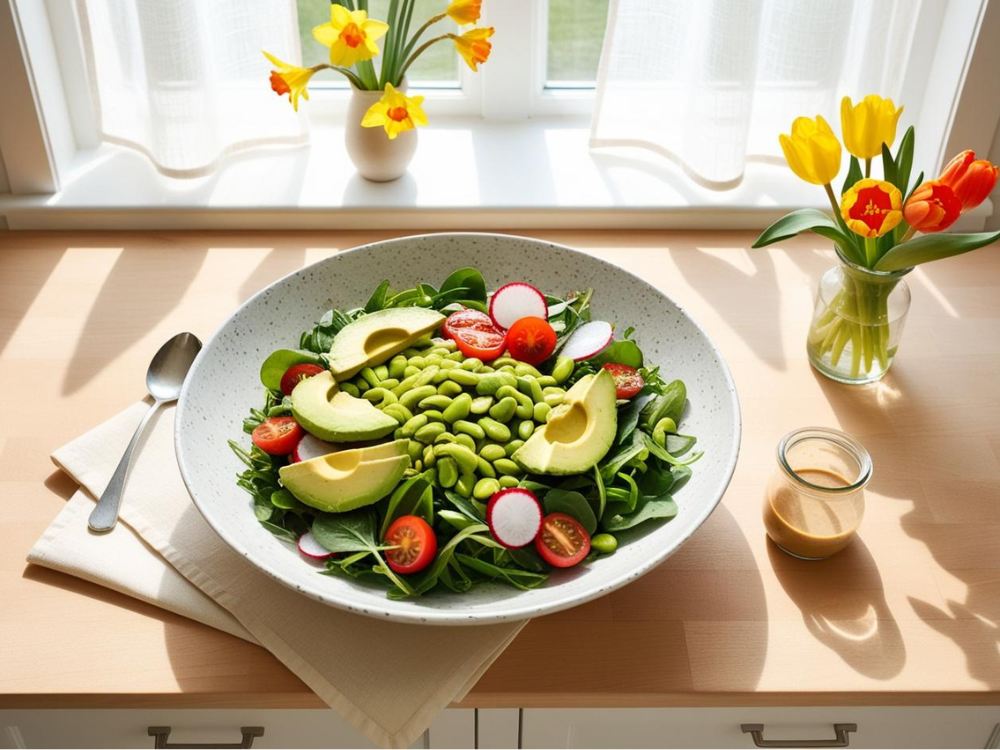


I’m excited to try this one now that the weather is permitting!